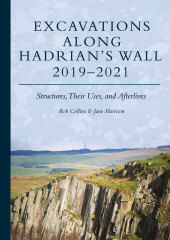Excavations Along Hadrian's Wall 2019-2021 : Structures, Their Uses, and Afterlives
256 p.
This study focuses on the fabric, construction and preservation of stretches of Hadrian's Wall in its more remote locations, providing significant insights into the places between the mile castles and important forts and associated settlements.The Hadrian's Wall Community Archaeology Project (WallCAP) conducted a series of fieldwork projects along the Hadrian's Wall corridor between 2019 and 2021. The work focused on sites that were poorly understood or under particular threat and aimed to improve understanding of them so they could be better managed in future. At several sites excavation was followed by conservation and consolidation work. This volume brings together the final reports of these excavations, at six Roman sites in the Wall corridor. As the sites were spread along the length of the Wall the character and afterlife of the Wall in very different landscape locations could be compared. An assessment of the Vallum at Heddon on the Wall identified how earthwork archaeology survived in a sloped, heavil
y ploughed landscape. Three excavations investigated the condition of the stone Wall curtain: at Port Carlisle, Walltown Crags, and Steel Rigg and Cats Stairs. At each site the Wall builders had responded to the demands of the local terrain and made use of local resources. At each site the Wall had a different post-Roman history. Excavations at the bridging point of the Cam Beck revealed for the first time how the Wall was carried over a 'minor' watercourse, and discovered traces of the Turf Wall. Small buildings were also identified just south of the Wall as it approached the bridge. At Corbridge Roman town, excavations on the northern periphery of the settlement demonstrated that from early in its history the most northerly town in Europe was of considerable extent. The area investigated showed that, even at the edge of town, shops lined the roads alongside well-appointed houses with bustling yards. Later on in the Roman period the town contracted behind walls and cremation burials were inserted by the road
. Each site is reported on independently, presenting the primary data for each investigation. The volume concludes with a synthetic analysis of what the results of these excavations together reveal about Hadrian's Wall, considering, amongst other things, construction details and the decay and destruction of the monument in the centuries following Roman occupation. [Publisher's text].
Special access authorizations may apply; please contact us for further information.
-
Informationen
ISBN: 9781789259469
THEMENBEREICHE


